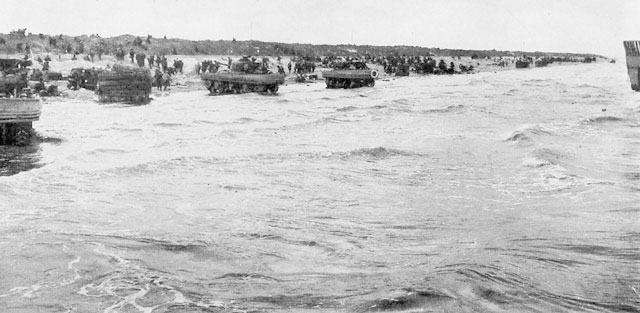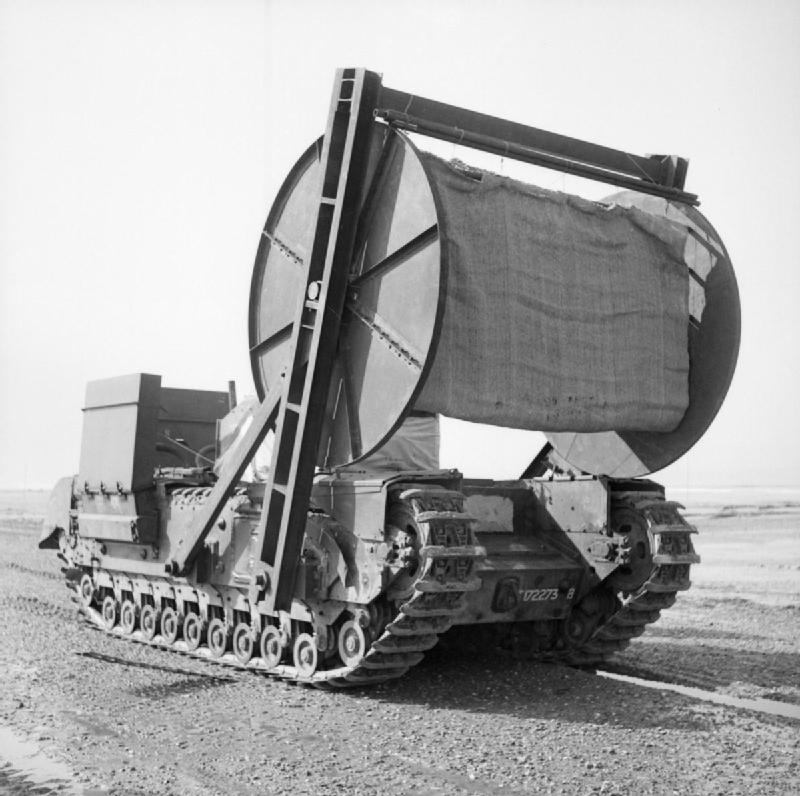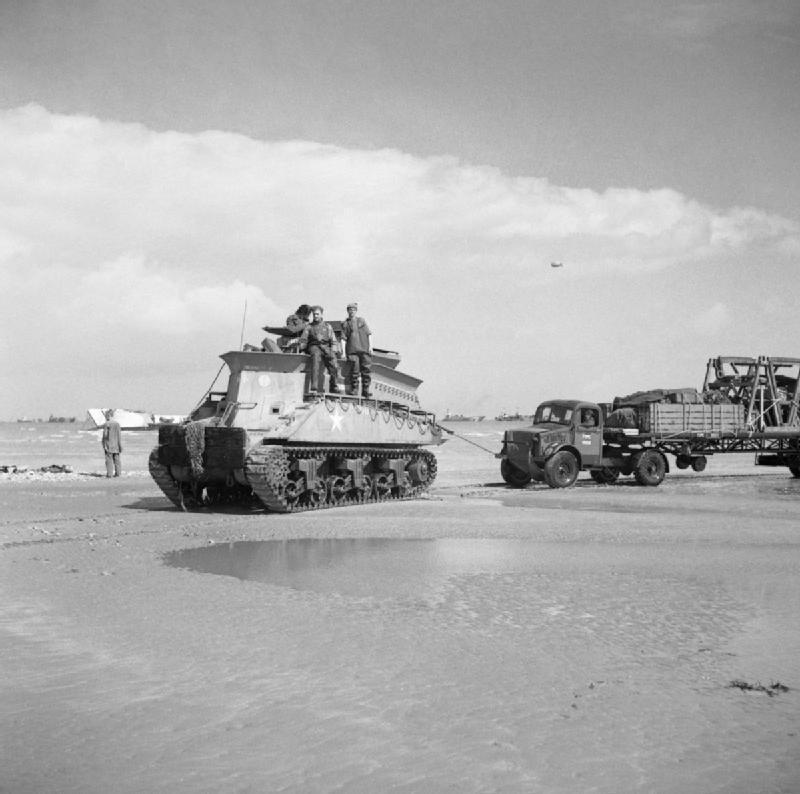The Allies used them for the first time during the landings in Normandy: the Duplex Drive Tanks. Duplex drives weren’t traditional armoured fighting vehicles. This particular kind of tank was a Sherman tank, tweaked to float on water thanks to a canvas flotation screen around the vehicle. Thanks to two propellers the tank engine was able to drive in the water. Because of its peculiar… characteristics and abilities, the DD tank was nicknamed the “Donald Duck.” It’s pretty spectacular, to be honest. The amphibious tank played a crucial role in the landings on the beaches of Normandy. Soldiers basically built their Sherman tank into a floating craft, making it much easier to land on shores and to cover infantry landing among the vehicles. There was one man that stood at the helm of developing these Donald Ducks. And they certainly weren’t his only inventions eagerly utilised by the Allies during the Second World War.

Gen. Percy Hobart
General Percy Hobart specifically designed these floating tanks for Operation Overlord, the landings on Normandy in June 1944. They supported the troops storming the beaches of Normandy, vulnerable to German machine-gun fire and artillery shelling.
During the landings on the beaches of Normandy, the most curious vehicles saw the light of day. Together with his specialist 79th Armoured Division, General Hobart took part in the preparations for D-Day. Hobart developed more unusual-looking specialist armoured fighting vehicles. The Duplex Drive Tank was just a part of a much larger contingent of special vehicles. Because of their looks, these vehicles were referred to as “Hobart’s Funnies.”
Before we get to about a dozen of Hobart’s “Funnies”, I’ll explain a bit about the man behind these curious vehicles. Hobart, nicknamed Hobo, was a British Major General and brother-in-law of Field Marshal Bernard Montgomery. He married Hobart’s sister, Elizabeth. Born in Naini Tal, India, he studied at Clifton College and at the age of 19 graduated from the Woolwich Royal Military Academy. Following his graduation, he joined the Corps of Royal Engineers, commonly known as the Sappers, and was stationed in India. Their task was to provide military engineering and other technical support to the British Armed Forces. And, well, Hobart certainly had some unique and creative ideas. But as we’ll see that certainly didn’t always serve him well and his superiors weren’t too impressed with his imagination.

During the First World War, he fought both in France with the 1st Bengal Sappers and the Middle East, current-day Iraq. He held multiple positions after the war ended, steadily rising through the ranks. He ended the war as a temporary Major, and by December 1937 he was a Major General. Within this capacity, he was tasked with reforming and training the newly established Mobile Force. Consisting of four armoured regiments, the Force was redesignated the 7th Armoured Division during the Second World War, also known as the Desert Rats.
But initially, Hobart wasn’t even present, or even in service when the Division saw action in North Africa for the first time. The Army forced him to retire in 1940; sources indicate this was because of his unusual convictions about mechanised warfare and its potential and possibilities. Basically, Hobart’s superiors considered him a bit of a nuisance and antagonistic character. Ironically, Hart’s pre-war writings greatly influenced German strategies regarding mechanised warfare. Yet as the war continued, Hobart’s unusual ideas began to seem like a genuine necessity to some British commanders.
A wake-up call to the British command that an amphibious landing on the French coast would be a meat grinder without adequate armoured support came in August 1942. It followed the disastrous Dieppe Raid. Basically, the raid was an amphibious landing with massive Allied casualties. In retrospect, the British commanders concluded that, among other things, due to the lack of reliable armoured support, within ten hours of the beginning of the raid, over sixty percent of all soldiers that landed near the German-occupied French port of Dieppe, were either killed, wounded or captured. As such, the British decided to develop tanks that could reach the coast shore by themselves, instead of having them dropped off by landing vessels. After the British military historian and theorist B.H. Lidell-Hart advocated for Hobart’s cause to Winston Churchill, he, in turn, reinstated him.

Reentering service, Hobart became the commander of an Armoured Division. Now, it wasn’t like Hobart suddenly started designing a dozen of his funnies in the remaining years of the war. Instead, most of his Funnies’ plans already existed thanks to developments during, or right after the First World War. Concept plans for amphibian tanks, or tanks with ploughs or rake-like structures to neutralise mines already existed. When he rejoined service, Hobart simply began collecting, expanding and integrating these curious vehicles in order for them to become operational properly… and effective.
The Duplex Drive Tank
We’ve already had a look at the Donald Duck, or Duplex Drive Tank. The Hungarian-born Miklós Straussler created the initial designs, which eventually allowed for the creation of the DD-tank. It is undoubtedly the most famous Funnie, and perhaps you recognised it when I introduced the swimming vehicle in this video. Basically, an American Sherman M4 Tank rotated its turret 180 degrees upon which the tank’s crew inflated the foldable floatation screen surrounding the tank. The rotating of the turret was necessary to maintain balance in the water.
As the footage shows after inflating the canvas, the four ‘walls’, if you will, remained above the surface of the water. Thirty-six vertical inflatable rubber ribs held it up. Thanks to its two propellers, its top speed was around seven kilometres per hour, so approximately the same as a marching soldier. Except it was in the water. And it was a heavy floating tank.
The Allies occasionally used the British Mark III Valentine tank as a DD-tank as well. However, the tank was much less fitted for it in comparison to the Sherman. Aside from landings on the Italian beaches, the Valentine tank was mainly used during training missions.
And its counterpart, the Sherman, certainly landed on Normandy. To be more specific: the DD-tanks were destined for Omaha Beach, and received the brunt of the fire. In total, 32 DD-tanks were supposed to sail onto the shores from approximately five kilometres off the coast. For these improvised sailing vessels, each weighing between 30 and 38 tonnes… well, it was quite the distance. Waves reached close to two metres in height, and of course, the tanks suffered heavy artillery and anti-tank gun attacks.

Precisely because of the expected resistance, the DD-tanks’ crews were outfitted with Davis Submerged Escape Apparatus, which was initially invented as an emergency escape apparatus for submarine crews. Thirty of the 32 tank crews ended up using the apparatus, not always successfully. Merely two DD-tanks managed to reach Omaha beach.
Elsewhere in October 1944, during the Battle of the Schelde in northern Belgium and the Netherlands, aside from the Buffalo amphibious vehicles, several DD-tanks actually managed to get to shore after travelling over double the distance at Omaha Beach, 11 kilometres, with relative ease. Multiple other funnies saw action during D-Day though, many of them looking like a stroke of genius had devised them… Or a stroke of madness.
Hobart’s other Funnies
A so-called Double Onion was a tank with a steel fence able to position explosives onto a bunker. As you can see on the photograph, the Double Onion placed explosives at a decent height, up to twelve meters. It made the vehicle great for putting a dent in the outer defences of bunkers or chipping away at the strength of walls.
Crabs were M4 Sherman Tanks fitted with a rotating flail consisting of a heavy metal chain, able to clear paths straight through minefields. The first time Crabs were used, they were put on Matilda tanks during the Battle of El Alamein in North Africa. But soon the Sherman M4 became the tank of choice. An unforeseen, but very welcome effect was that the flails could also easily cut through barbed wire. This was a crucial asset as after the Atlantikwall was breached Allied soldiers often ran into massive barbed wire obstacles put up by the Germans.
During the Battle of Overloon in the Netherlands, the British used Crabs to make their way through rivers and minefields. Meanwhile, the Crabs were happy with Churchill tanks equipped with fascines, allowing them to cross the muddy landscape.
Fascines were used during the First World War as well. Fascines were bundles of wood or other material with the purpose to allow vehicles to cross through rugged territory. It could merely be wet, muddy or uneven territory. But fascines also were very welcome against anti-tank ditches. Especially during rainy autumn, turning lands into marshes, these were very useful. In the photograph you’re seeing, taken in 1943, a Churchill tank carrying a fascine crosses a ditch using one in the process. It basically shows the entire way fascines were utilised.


The Canal Defence Light generally was a modified British Matilda or American M3 Grant Lee Tank with a tower fitted with an intense stroboscopic carbon-arc light. It could send out blinding laser beams with such strength that the CDL was even effective during the daytime. Still, it rarely saw action during the war and even among Hobart’s funnies it was a bit of the odd one out. This is one of the Funnies that did not see action during D-Day, although it was used in November that year during Operation Clipper.
One of the most spectacular vehicles must have been the tanks outfitted with a flamethrower. These so-called Crocodiles had their machinegun exchanged for a flamethrower situated in the operator’s cabin. An armoured container located within the tank contained between 500 and 1800 litres of fuel. Using strong pressure, the flamethrower could emit 90 bursts of fire a second, reaching up to 130 metres in the distance.

AVRE’s , short for Armoured Vehicle Royal Engineers, were a series of armoured military engineering vehicles. They were modified to be able to launch heavy mortars, ‘flying dustbins’, 18 kilo heavy mortars, onto enemy positions such as bunkers. The turret of a Churchill tank was removed and in its place came a 290 mm petard spigot mortar. These vehicles were ideal for the carrying of equipment as well, and were a welcome way to transport the aforementioned fascines. Another purpose for it was the so-called Churchill AVRE Bobbin. This vehicle carried a bit more of an advanced fascine, carrying a canvas roll that it was able to roll out over soggy ground so that itself, and other vehicles could safely cross the difficult terrain.
Beach Armoured Recovery Vehicles, or… Well BARV for short, were vehicles used for amphibious landings. During the landings in Normandy, about five dozen of these modified M4A2 Sherman tanks saw action. Thanks to the bottom side of the vehicle being made waterproof, it served as a rescuer of other vehicles in the sea or on the beach. It was also able to push stranded vehicles back in the sea. The vehicles used during D-Day were able to operate in up to over 2.5 metres deep water. Among its crew was a professional diver whose task was to secure the tow rope to a stranded vehicle to recover it.

A bit more forgotten and perhaps worthy of its own video entirely is the Allied Operation Dragoon. Hobart’s Funnies played a crucial role during that operation. In August 1944 there was a landing operation in Provence, southern France. The already weakened German forces were swiftly pushed back and important French port cities were rapidly captured.

Hobart’s Funnies ended up playing a crucial role in the European battle theatre until after the Allies crossed the Rhine river. Now, during that crossing of the Rhine river, the Allies ran into quite some trouble as the retreating Germans blew up every bridge they used. There was one bridge at Remagen, however, that they were too late to blow up. The Battle of Remagen was daring and spectacular, crucial in securing a passage for Allied Armoured Divisions into the German heartlands. If you want to know more about it, there should be an end-card for you to click on-screen any minute now.

